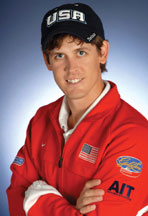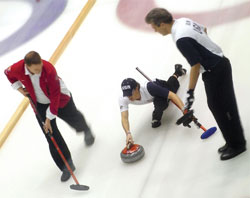CAMPUS
BUZZ
At Play: Nick Myers
Staff member eyes run at 2010 Olympics

etween frying burgers and filling soft drink orders, Nick Myers managed a lot of ice time growing up in Mapleton, Minn.
The UT Arlington construction project coordinator remembers his mom running the lunch counter at a local ice rink and encouraging him to get on the ice to "curl" whenever business was slow.
"Back then, I used to ride the ‘rock,' " he says of the 42-pound stone with a handle.
Myers is a world-class athlete in curling, a Winter Olympics sport in which participants slide the stone toward a target. Think large-scale shuffleboard-on ice. Team members sweep with brooms to direct the stone.
"All my family played," said Myers, who has two brothers and two sisters. "I'm the only one who does it now on a competitive level. It's a big family sport up there."
He and his team finished fourth in Karuizawa, Japan, in February at an international competition of eight men's and eight women's teams.

CURLINGFACTS
Stone. Costs up to $1,000 per rock. Weighs 42 pounds, is 12 inches in diameter, and six to eight inches high. Life of a rock is about 80 years.
Shoes. Cost up to $300, but a pair can be had for about $60. One shoe is a tennis shoe; the other is coated on the bottom with Teflon or stainless steel for sliding.
Brooms. Cost up to $150. Bristles are made of synthetic material or horsehair. Higher-end models have carbon fiber handles.
Myers and his Minnesota buddies are contemplating a run at the 2010 Olympics. The U.S. curling trials will be in Denver in February 2009. Team Farbelow (for skipper Mike Farbelow) has competed in three Olympic trials, winning bronze and silver. The team is the reigning U.S. Club National Champion and has won four national titles and three state championships. Myers is the vice skipper; Tim Solin and Tim Gartner are the other team members.
The skipper is the strategist and stands near the scoring circles, called the house. He signals the strategy he wants to use to land the stone in a particular area of the house or block an opponent's next throw.
"What I like most about it is the strategy involved," Myers said. "It's an art, a true skill. We use a stopwatch to time the ice. We study how much rotation to put on the rock, things like that. We can make the rock travel farther and straighter with sweeping."
Besides the skipper and the thrower, the other team members sweep-either frantically or not much. The skipper or vice skipper tells the sweepers what to do, depending on the ice conditions and other factors. Everyone takes a turn sliding the rock.
Myers was a little worried about traveling to his new post with UT Arlington since area places for curling are limited. He practices at the Duncanville Stars Center.
"Up there, they've got huge venues for curling and hockey. But even here in the states, curling participation is far less than in Canada," he said, noting that there are 15,000 curlers in the United States compared to more than a million north of the border.
Getting children involved is key to the sport's U.S. expansion.
"We used to get together for a bonspiel," Myers said of the Scottish word for a family-friendly competition on the ice-usually on a frozen pond-with the rock. "You're never going to meet nicer people than those in curling. It's a lot of fun for the whole family. And we had enough in my family to field a whole team."
— Herb Booth
Other Stories
Deep thinkers
Pilot projects encourage students to take charge of their own learning
Mavericks Personified: Wajiha Rizvi
Recent graduate takes a campaign detour
Family Friendly
Dan and Grace Cruz never dreamed they'd one day attend college alongside sons Mike and Nick. It's hectic but worth it, they all say.
Arctic exploration
Researchers examine Alaskan tundra for insight into climate warming
What’s in a name?
Building namesakes include former presidents, deans, coaches and an astronaut
Contact Us
Office of University Publications
502 S. Cooper St.279 Fine Arts Building
Box 19647
Arlington, TX 76019-0647
